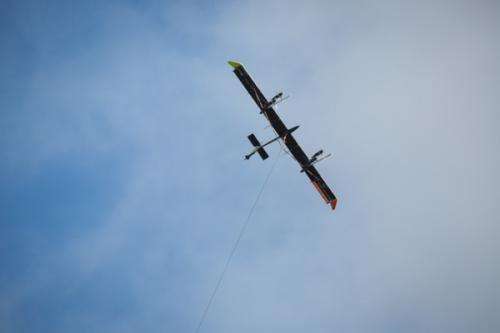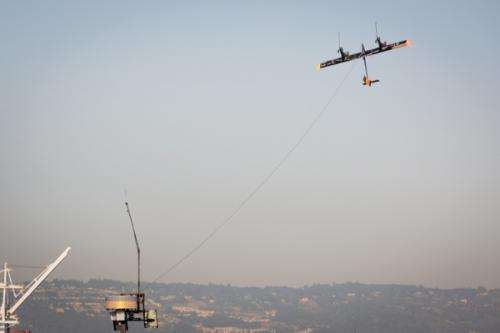High-altitude wind turbines have potential to generate large amounts of electricity

(Phys.org) —Wind turbines hovering high in the air and tethered to the ground, like kites, have the potential to generate huge amounts of electricity, based on a recent wind availability study led by the University of Delaware.
Researchers pinpointed tracts of the atmosphere ideal for locating airborne wind energy (AWE) devices, which convert kinetic energy from wind into electricity. Findings published in the April issue of Renewable Energy show that there are enough areas usable by airborne turbines to produce several terawatts of electric power annually—more than enough needed to meet worldwide demands.
"These areas, which we call 'wind speed maxima,' form much more often and in more regions than we thought," said study lead author Cristina Archer, associate professor in UD's College of Earth, Ocean, and Environment. "That was a surprise."
If airborne wind turbines sound like a high-flying idea, they're not. More than 20 companies are developing various versions of the technology, with over 100 related patents filed in the United States alone.
"There are prototypes, but no one has a commercially viable product ready for market yet," said Damon Vander Lind of the Google-backed Makani Power. "This means that widespread deployment in farms is still a few years out."
Unlike their land-based and offshore counterparts, airborne turbines can reach extreme heights where wind speeds are very fast. They also use less-expensive materials, have fewer visual and audible impacts and can be adjusted to the precise level at which winds are quickest at any given time. The systems are intended for use in special airspace to avoid interfering with airplanes, and they are not to be deployed during severe weather.

Initially the incipient industry hoped to reach the jet streams, where powerful air currents flow at heights used by airplanes. The weight of the 30-kilometer-long electricity transmission tethers, however, proved too heavy to be able to keep turbines aloft.
Today companies plan to reach heights between 200 meters and 3 kilometers, Archer said. The best spots for AWE farms are where winds consistently blow at high speeds at the lowest possible altitude, cutting down on tether drag.
Archer used a meteorological model to analyze hourly global weather data from 1985 to 2005 from the National Center for Atmospheric Research (NCAR). She identified areas where wind speeds were greater than 10 meters per second for at least 15 percent of the time each month at heights less than 3 kilometers.
"These wind speed maxima are jet-like profiles with higher than expected wind speeds," Archer said.
She and colleagues Luca Delle Monache of NCAR and Daran Rife of GL Garrad Hassan were surprised to find wind speed maxima over a quarter of the planet. Prime examples are the American Great Plains, areas over the ocean near the equator called Hadley cells and the Somali jet offshore the Horn of Africa.
The team then set out to determine how much electricity could be produced if airborne wind energy devices tapped into those wind speed maxima. Their estimate assumed three different densities of devices and excluded polar and oceanic regions.
At the intermediate density of airborne turbines, the global potential exceeded 7.5 terawatts, which is about three times higher than worldwide annual electricity demand. Wind speed maxima, the researchers concluded, are an untapped resource for pollution-free electricity.
In future studies, Archer said the estimates could be refined to account for transmission losses, climate feedbacks, land use and other considerations to give a more practical calculation.
At this point, she is one of only a handful of researchers examining these types of topics. As the field has grown, she has helped bring companies and researchers interested in airborne wind energy together at annual conferences, having organized the first one in California in 2008. She has been interviewed for an upcoming documentary on airborne wind energy, and a preview can be seen through this link.
Archer is an associate professor of physical ocean science and engineering and geography in the College of Earth, Ocean, and Environment and a member of UD's Center for Carbon-Free Power Integration. Her wind energy expertise focuses on the intersection of meteorology and energy engineering issues, having written the lone chapter on meteorology in a recent book on airborne wind energy.
"I'm the godmother of this field," she said with a smile. "I've been following it from the beginning."
More information: Cristina L. Archer, Luca Delle Monache, Daran L. Rife, "Airborne wind energy: Optimal locations and variability," Renewable Energy, Volume 64, April 2014, Pages 180-186, ISSN 0960-1481, dx.doi.org/10.1016/j.renene.2013.10.044.
Journal information: Renewable Energy
Provided by University of Delaware




















